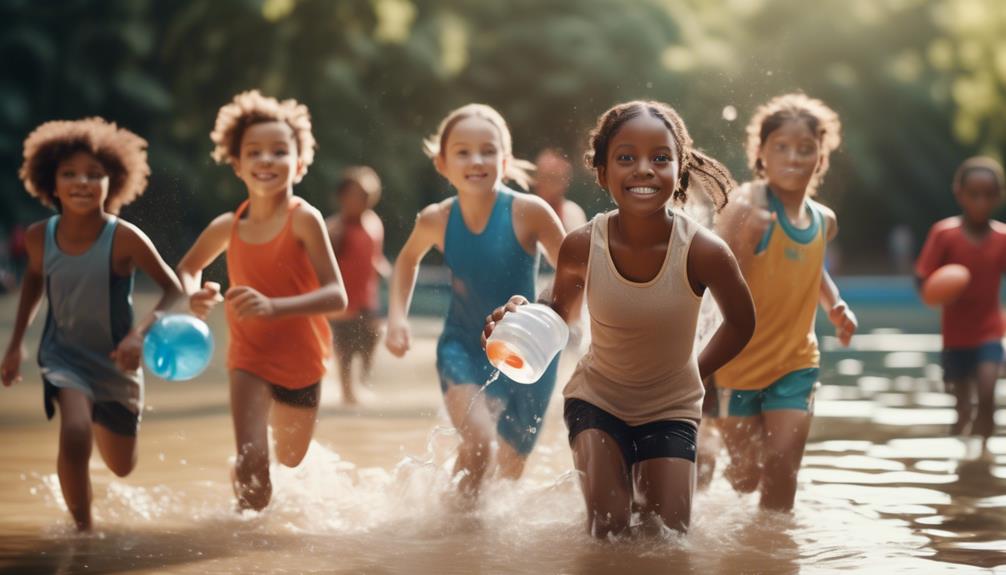How to Find Out the Best Ways to Hydrate Your Child

The Best Ways to Hydrate Your Child:
Expert Tips and Practical Strategies for Ensuring Optimal Hydration and Health.
Hydration is crucial for children's overall health and well-being. Here are some expert tips and practical strategies to ensure your child stays properly hydrated:
- Encourage regular water intake: Make sure your child drinks water throughout the day. Keep a water bottle easily accessible and remind them to take sips regularly.
- Limit sugary drinks: Minimize your child's intake of sugary beverages such as soda, fruit juices, and sports drinks. These drinks can contribute to dehydration and negatively impact their health.
- Offer hydrating foods: Include fruits and vegetables with high water content in your child's diet. Watermelon, cucumbers, oranges, and strawberries are excellent choices.
- Set a good example: Be a role model by prioritizing your own hydration. When children see their parents drinking water regularly, it encourages them to do the same.
- Make it fun: Get creative by adding fruits or herbs to water, making infused water, or using colorful cups and straws. This can make drinking water more appealing to children.
- Schedule water breaks: If your child is involved in physical activities or sports, remind them to take regular water breaks to stay hydrated.
Remember, maintaining proper hydration is essential for your child's physical and mental well-being. By following these expert tips and implementing practical strategies, you can ensure your child stays hydrated and healthy.
Understand Your Child's Hydration Needs
To ensure your child stays properly hydrated, it's crucial to understand their unique hydration needs. Dehydration can have serious consequences for children, affecting their physical and cognitive performance. Encouraging your child to drink fluids throughout the day is essential for maintaining their hydration levels.
Water and unflavored milk are the optimal choices for keeping your child hydrated. These drinks provide the necessary fluids without the added sugars and artificial ingredients found in sports drinks and sodas. It's important to avoid these sugary beverages as they can contribute to dehydration and other health issues.
To help your child drink enough fluids, keep water handy at all times. Consider using refillable water bottles that are easy to carry around. You can also make hydration fun by using colorful cups or infusing water with fruits or herbs for a refreshing twist.
The recommended daily fluid intake for children varies by age. Monitoring your child's urine color and looking out for signs of dehydration, such as headaches and fatigue, can help you ensure they're getting enough fluids. Remember, as a parent, your own hydration is also important. Setting a good example by drinking water and staying hydrated won't only benefit your child but also contribute to your own well-being.
Understanding your child's unique hydration needs and taking steps to keep them properly hydrated will help promote their overall health and well-being. By providing them with the right fluids and setting a good example, you can help your child develop healthy hydration habits that will last a lifetime.
Consult With a Pediatrician for Personalized Advice
When it comes to your child's hydration, it's important to seek expert medical guidance. Consulting with a pediatrician will provide you with personalized advice that takes into account your child's unique needs.
They can help you develop individualized hydration strategies based on factors such as age, weight, activity levels, and any specific health conditions your child may have.
Trusting a pediatrician ensures that you receive accurate and reliable information to keep your child properly hydrated.
Expert Medical Guidance
For personalized guidance on hydrating your child, consult with a pediatrician who can provide expert medical advice tailored to your child's specific needs.
Pediatric experts can offer valuable insights on how to ensure your child stays hydrated and prevent dehydration. They can assess your child's water intake requirements based on their age, weight, activity level, and overall health.
By consulting with a pediatrician, you can receive recommendations on the best ways to encourage your child to drink water and develop healthy hydration habits. They can also educate you on the signs of dehydration to watch out for and when to seek medical attention.
Individualized Hydration Strategies
Developing individualized hydration strategies for your child is crucial for ensuring they stay properly hydrated, and consulting with a pediatrician can provide personalized advice based on their age, weight, and activity level. By tailoring hydration recommendations to your child's specific needs, you can help ensure they receive the right amount of fluids to stay healthy and hydrated. To better understand your child's hydration status, monitor their urine color and frequency, as dark yellow urine may indicate dehydration. Encourage regular hydration by making it fun with colorful cups, silly straws, and infused water with fruits and herbs. Incorporate water-rich foods like watermelon, cucumber, and strawberries into their diet to support hydration. Additionally, consider using a water bottle to track their fluid intake. The table below provides a general guideline for the number of cups per day your child should aim for based on their age:
| Age Group | Cups per Day |
|---|---|
| 1-3 years | 4-5 cups |
| 4-8 years | 5-7 cups |
| 9-13 years | 7-9 cups |
| 14-18 years | 8-11 cups |
| 19+ years | 8-12 cups |
Explore Different Hydration Options for Children
To ensure your child stays properly hydrated, consider exploring different options beyond just water and unflavored milk. While water is the best fluid for replenishing the body's lost water, it's understandable that kids may want more variety in their hydration options. Luckily, there are other healthy choices available that can keep your child hydrated and satisfied.
One option to consider is incorporating water-rich snacks into your child's diet. Fruits such as watermelon, oranges, and grapes have high water content and can help hydrate your child. Additionally, vegetables like cucumber and celery are also great choices as they contain a good amount of water.
Another option is flavored water. While you should be cautious of added sugars, there are many flavored waters on the market that contain little to no sugar. These can be a fun and tasty way to encourage your child to drink more fluids.
Smoothies made with water or unflavored milk can also be a great hydration option. You can include fruits, vegetables, and even some yogurt to make a refreshing and hydrating drink for your child.
Encourage Regular Water Intake Throughout the Day
Now let's talk about how you can encourage your child to drink water throughout the day.
Daily reminders can help keep water intake top of mind, so consider setting up a routine where you both take water breaks together.
Fun water bottle options, like ones with their favorite characters or colors, can make hydration more enjoyable for your child.
Daily Water Reminders
Make staying hydrated a priority for your child by incorporating daily water reminders into their routine. Set regular reminders throughout the day to encourage your child to drink water. Remind them to take sips from a refillable water bottle, especially during school hours.
You can make hydration fun by using colorful cups or silly straws to entice them to drink more water. Consider infusing water with fruits, vegetables, and herbs to add flavor and variety, making it more enjoyable for your child.
Encourage your child to monitor their urine color as it can indicate their hydration level. Teach them that a light, pale yellow color means they're well-hydrated.
Finally, remember that children need different amounts of water depending on their age and activity level. Aim for them to drink a full 8 ounces of water, 8 times a day.
Fun Water Bottle Options
Personalizing your child's water bottle is a great way to make hydration fun and encourage regular water intake throughout the day. Here are some fun water bottle options to consider:
- Get creative: Personalize the water bottle with stickers, labels, or permanent markers to make it fun and unique for your child. Let them choose their favorite designs or colors to make it truly special.
- Add a twist: Consider using a water bottle with an opening for swirly straws or visit an art supply store together to make decorating the bottle a fun activity. This way, your child will have a personalized water bottle that they'll be excited to use.
- Make it tasty: Freeze citrus slices, strawberries, or watermelon chunks to add a refreshing twist to water and make hydration more enjoyable. You can also experiment with making homemade frozen fruit treats like yogurt popsicles to encourage fluid intake in a fun way.
Incorporate Water-Rich Foods Into Your Child's Diet
To ensure your child stays properly hydrated, incorporating water-rich foods into their diet is a simple and effective way to promote hydration. Children have unique hydration needs, and providing them with plenty of fluids is crucial to prevent the risk of dehydration. One way to meet their hydration needs is by including water-rich foods in their meals and snacks.
Fruits like strawberries or watermelon are excellent choices as they've high water content. These juicy fruits not only provide hydration but also offer essential vitamins and minerals for your child's overall health. Additionally, vegetables like cucumber and zucchini can be incorporated into salads or sliced as a refreshing snack. These vegetables contain a significant amount of water and are a great way to keep your child hydrated.
Another way to incorporate water-rich foods is by preparing hydrating soups. Gazpacho, made with tomato, cucumber, and bell pepper, or roasted carrot and beet soup are delicious options that provide hydration while satisfying your child's taste buds.
You can also make hydration more enjoyable by introducing infused water. Adding fruits, vegetables, or herbs to water creates a refreshing and flavorful drink that your child will love. And for a tasty treat, homemade frozen popsicles made with fruit and yogurt are an excellent choice to keep your child hydrated and satisfied.
Monitor Signs of Dehydration in Your Child
To ensure your child stays properly hydrated, it's important to monitor for signs of dehydration, as certain indicators can help determine their hydration status. Here are some key signs to watch out for:
- Urine color: Pay attention to the color of your child's urine. Aim for a light yellow shade, as darker urine can indicate dehydration. If your child's urine is dark, it's a sign that they need more fluids.
- Recognizing signs: Teach your child to recognize signs of dehydration, such as headaches, nausea, fatigue, and dizziness. By empowering them to identify these symptoms, they can take action and drink more fluids when needed.
- Encourage regular water intake: Make sure your child drinks water regularly throughout the day. The amount of water they need depends on their age, but generally, aim for 4-8 cups a day. Encouraging healthy habits early on can help them stay well hydrated.
Adjust Hydration Strategies Based on Your Child's Activity Level
Does your child engage in regular physical activities?
It's important to adjust hydration strategies based on their activity level to ensure they stay properly hydrated. During periods of physical activity, such as playtime, sports, or hot weather, your child may be losing fluids through sweat. To prevent dehydration, it's essential to increase their water intake and provide frequent hydration breaks. Encourage your child to drink water before, during, and after physical activities to replenish the fluids they've lost.
In addition to water, electrolyte-rich fluids like sports drinks can also be beneficial for active children. These drinks help maintain energy levels and replenish lost minerals during prolonged physical activities. However, it's important to offer sports drinks in moderation and not as a substitute for water.
Teaching your child to recognize signs of dehydration is crucial. Look out for increased fatigue, dark urine, and a dry mouth. If these signs are present, it's important to adjust their water intake accordingly.
To make hydration more appealing for your child, consider using fun and colorful water bottles, silly straws, or flavored water. This can help encourage them to drink more water, especially during active periods.
Frequently Asked Questions
How Can I Rehydrate My Child Fast?
To rehydrate your child fast, try giving them water or unflavored milk. Avoid sugary drinks like sodas and juices. Incorporate hydrating foods and electrolyte drinks. Remember, water intake is essential for their health.
What Is the Best Thing for Hydration for Kids?
To ensure your child stays hydrated, it's important to establish healthy hydration habits. Offer nutritious options like fruits, vegetables, and water. During physical activities, encourage regular water breaks. For picky eaters, try flavored water or homemade popsicles. Busy parents can set reminders or use water tracking apps.
What Are 3 Warning Signs of Dehydration?
Feeling tired, weak, and dizzy are three warning signs of dehydration in children. It's important to recognize these symptoms and ensure your child stays properly hydrated for their health and well-being.
How Can I Increase My Child's Fluids?
To increase your child's fluids, try creative hydration with fun drinks like infused water or using colorful cups. Teach the importance of water and monitor urine color. Hydration hacks and involving siblings can also help. Stay hydrated too!











